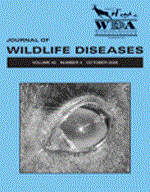Rio Grande wild turkeys (Meleagris gallopavo intermedia) were evaluated as potential hosts of ixodid ticks, lice, and Lyme disease spirochetes (Borrelia burgdorferi sensu lato [s.l.]) in three state parks in Sonoma County, California, USA, during 2003 and 2004. In total, 113 birds were collected, 50 (44.2%) of which were found to be infested by 361 ixodid ticks representing three species: the western black-legged tick (Ixodes pacificus, n=248), the rabbit tick (Haemaphysalis leporispalustris, n=112), and one American dog tick (Dermacentor variabilis). Year-round the prevalence of all ticks combined was unrelated to the age or sex of turkeys, and the prevalence of infestation by I. pacificus (35.4%) was significantly higher than it was for either H. leporispalustris (14.2%) or D. variabilis (0.9%). The proportion of the two prevalent tick species differed significantly by life stage with 86.3% of the I. pacificus and 82.1% of the H. leporispalustris enumerated being nymphs and larvae, respectively. Three species of lice were collected, including the chicken body louse Menacanthus stramineus (12.5% of total), Chelopistes meleagridis (37.5% of total), and Oxylipeurus polytrapezius (50% of total). The records for all three ticks are the first ever from wild turkeys, and those for the lice are the first from this host in the far-western United States. Wild turkeys potentially were exposed to the feeding activities of I. pacificus nymphs infected with B. burgdorferi s.l. as 15% of host-seeking nymphs (n=200) collected in woodlands used by turkeys as roosting or foraging areas were infected mainly with B. burgdorferi sensu stricto (s.s.). However, only one (1%) of 90 turkey blood specimens tested by PCR contained B. burgdorferi s.s., and four in vitro, complement-protein assays demonstrated that domestic turkey serum is moderately bacteriolytic for this spirochete. Taken together, these findings indicate that wild turkeys are important avian hosts of I. pacificus nymphs, but they appear to be inconsequential hosts of B. burgdorferi s.l.
How to translate text using browser tools
1 October 2006
WILD TURKEY (MELEAGRIS GALLOPAVO) AS A HOST OF IXODID TICKS, LICE, AND LYME DISEASE SPIROCHETES (BORRELIA BURGDORFERI SENSU LATO) IN CALIFORNIA STATE PARKS
Robert S. Lane,
Thomas F. Kucera,
Reginald H. Barrett,
Jeomhee Mun,
Chunling Wu,
Vincent S. Smith

Journal of Wildlife Diseases
Vol. 42 • No. 4
October 2006
Vol. 42 • No. 4
October 2006
Borrelia burgdorferi
complement
ixodid ticks
lice
wild turkey




